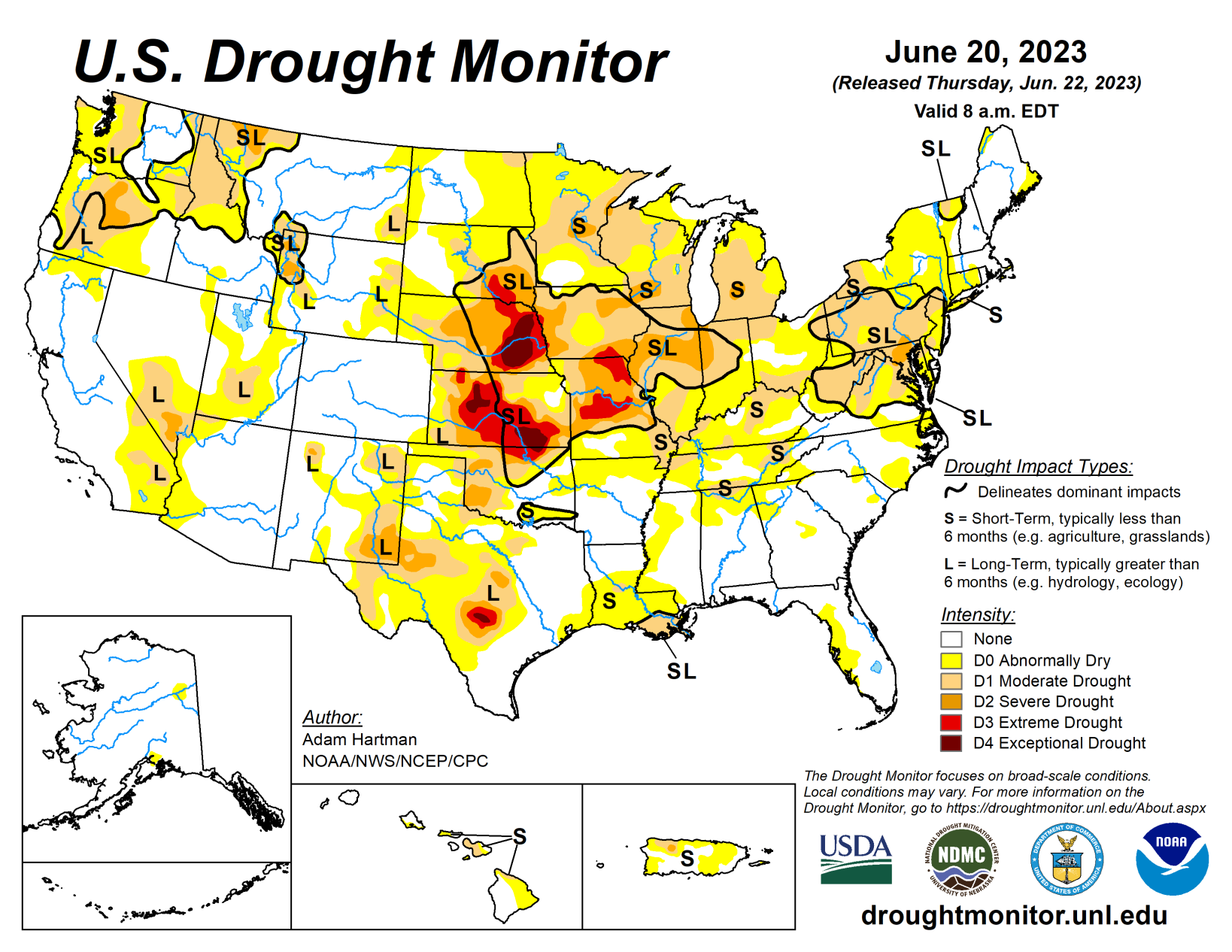Drought footprint still found in 3 High Plains states

Much of the lower 48 states experienced near to below normal temperatures this past week, with the exception of parts of the northern Great Plains, Upper Midwest, southern Texas, and parts of the Lower Mississippi Valley.
Large portions of southern Texas experienced excessive heat this week, with daytime high temperatures averaging well above 100 degrees Fahrenheit for several locations. A mean frontal boundary draped across much of the lower 48 states resulted in periods of heavy rainfall across portions of the western Great Plains and Intermountain West, leading to improvements to drought conditions across much of the western half of the lower 48 states.
Another round of deterioration was warranted again this week across much of the Midwest and eastern Great Plains, where below average precipitation continued to add to precipitation deficits that go back several months.
Several rounds of heavy rainfall associated with clusters of thunderstorms traversed portions of the Southern region from Oklahoma to Mississippi, leading to targeted improvements to abnormal dryness (D0) and drought conditions. Additional improvements to the drought depiction are also warranted across portions of the Texas Panhandle, where drought indicators have continued to improve due to well above average (in some cases record) rainfall over the past 60 days.
Conversely, targeted degradations are warranted across parts of the Lower Mississippi and Tennessee Valleys, where short-term dryness continues to increase. Excessive heat, especially during the latter portions of the week, helped to exacerbate dryness across portions of southern Louisiana and coastal areas of eastern Texas, where 30-day rainfall deficits continue to increase.
Despite predominantly near to below normal temperatures across much of the Midwest, excluding the Upper Midwest and the western Corn Belt, much of the region did not see appreciable rainfall. As a result, short-term (30 to 90 day) dryness continued to worsen, leading to widespread deterioration.
Much of the Northern Plains received below average rainfall this week, adding to short-term precipitation deficits. In conjunction with the below average weekly rainfall, above normal temperatures and high winds (typical for this region) only acted to exacerbate worsening drought conditions by increasing evaporation from soils and vegetation. As a result, widespread degradation of abnormal dryness (D0) and drought was warranted this week across the Dakotas.
Degradation was also warranted farther southward, extending across the eastern Great Plains all the way to Kansas, despite more seasonal daytime high temperatures this week. Conversely, across western portions of the High Plains region, another round of improvements is warranted, as yet another week of above normal rainfall (with many areas receiving upwards of 2 inches of rainfall, with locally higher amounts) was observed across many areas, leading to improvements to long-term drought conditions.
Looking ahead
According to the Weather Prediction Center, over the next six days (June 22 to 27) above normal temperatures are forecast to dissipate and become more seasonal across the Great Lakes and Middle and Upper Mississippi Valley, and become confined to the south-central U.S.
Parts of the Southern Plains could see record heat this week, as temperatures are likely to soar well above 100 degrees for many locations, with the potential for some locations to exceed 110 degrees. Much of the remainder of the lower 48 states is likely to experience seasonal to below normal temperatures. WPC predicts above normal precipitation across portions of the central and northern Plains and Upper Midwest, with the potential for several areas to receive in excess of 3 inches of rainfall.
During the next six to 10 days (June 27 to July 1), the Climate Prediction Center favors near to below normal temperatures are also predicted across much of the northern tier states from the northern Plains to the Great Lakes, and southeastward into the Mid-Atlantic.
Above normal temperatures are strongly favored across the south-central U.S., with the potential for record heat across portions of the southern Plains and Lower Mississippi Valley. Near and above normal precipitation is favored across much of the lower 48 states. However, below normal precipitation is more likely across the Four Corners region, extending eastward into the southern Plains and Lower Mississippi Valley.



